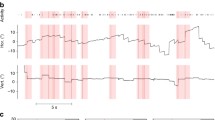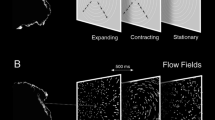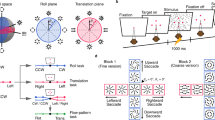Abstract
The control of self-motion is supported by visual, vestibular, and proprioceptive signals. Recent research has shown how these signals interact in the monkey medio-superior temporal area (area MST) to enhance and disambiguate the perception of heading during self-motion. Area MST is a central stage for self-motion processing from optic flow, and integrates flow field information with vestibular self-motion and extraretinal eye movement information. Such multimodal cue integration is clearly important to solidify perception. However to understand the information processing capabilities of the brain, one must also ask how much information can be deduced from a single cue alone. This is particularly pertinent for optic flow, where controversies over its usefulness for self-motion control have existed ever since Gibson proposed his direct approach to ecological perception. In our study, we therefore, tested macaque MST neurons for their heading selectivity in highly complex flow fields based on the purely visual mechanisms. We recorded responses of MST neurons to simple radial flow fields and to distorted flow fields that simulated a self-motion plus an eye movement. About half of the cells compensated for such distortion and kept the same heading selectivity in both cases. Our results strongly support the notion of an involvement of area MST in the computation of heading.






Similar content being viewed by others
References
Beintema JA, Van den Berg AV (1998) Heading detection using motion templates and eye velocity gain fields. Vision Res 38:2155–2179
Beintema JA, Van den Berg AV, Lappe M (2004) Circular receptive field structures for flow analysis and heading detection. In: Vaina LM, Beardsley SA, Rushton S (eds) The structure of receptive fields for flow analysis and heading detection. Kluwer Academic Publishers, Norwell, pp 223–248
Ben Hamed S, Duhamel JR, Bremmer F, Graf W (2002) Visual receptive field modulation in the lateral intraparietal area during attentive fixation and free gaze. Cereb Cortex 12:234–245
Bradley DC, Maxwell M, Andersen RA, Banks MS, Shenoy KV (1996) Mechanisms of heading perception in primate visual cortex. Science 273:1544–1547
Bremmer F, Ilg UJ, Thiele A, Distler C, Hoffmann KP (1997) Eye position effects in monkey cortex. I. Visual and pursuit-related activity in extrastriate areas MT and MST. J Neurophysiol 77:944–961
Bremmer F, Kubischik M, Pekel M, Lappe M, Hoffmann KP (1999) Linear vestibular self-motion signals in monkey medial superior temporal area. Ann N Y Acad Sci 871(272–81):272–281
Bremmer F, Duhamel J-R, Ben Hamed S, Graf W (2002) Heading encoding in the macaque ventral intraparietal area (VIP). Eur J Neurosci 16:1554–1568
Britten KH, van Wezel RJ (1998) Electrical microstimulation of cortical area MST biases heading perception in monkeys. Nat Neurosci 1:59–63
Britten KH, van Wezel RJ (2002) Area MST and heading perception in macaque monkeys. Cereb Cortex 12:692–701
Cutting JE, Vishton PM, Fluckiger M, Baumberger B, Gerndt JD (1997) Heading and path information from retinal flow in naturalistic environments. Percept Psychophys 59:426–441
Duffy CJ, Wurtz RH (1991a) Sensitivity of MST neurons to optic flow stimuli. I. A continuum of response selectivity to large-field stimuli. J Neurophysiol 65:1329–1345
Duffy CJ, Wurtz RH (1991b) Sensitivity of MST neurons to optic flow stimuli. II. Mechanisms of response selectivity revealed by small-field stimuli. J Neurophysiol 65:1346–1359
Duffy CJ, Wurtz RH (1997) Planar directional contributions to optic flow responses in MST neurons. J Neurophysiol 77:782–796
Duhamel JR, Bremmer F, BenHamed S, Graf W (1997) Spatial invariance of visual receptive fields in parietal cortex neurons. Nature 389:845–848
Erickson RG, Thier P (1991) A neuronal correlate of spatial stability during periods of self-induced visual motion. Exp Brain Res 86:608–616
Froehler MT, Duffy CJ (2002) Cortical neurons encoding path and place: where you go is where you are. Science 295:2462–2465
Galletti C, Squatrito S, Battaglini PP, Grazia MM (1984) ‘Real-motion’ cells in the primary visual cortex of macaque monkeys. Brain Res 301:95–110
Galletti C, Battaglini PP, Aicardi G (1988) ‘Real-motion’ cells in visual area V2 of behaving macaque monkeys. Exp Brain Res 69:279–288
Galletti C, Battaglini PP, Fattori P (1990) ‘Real-motion’ cells in area V3A of macaque visual cortex. Exp Brain Res 82:67–76
Gibson JJ (1950) The perception of the visual world. Houghton Mifflin, Boston
Graziano MS, Andersen RA, Snowden RJ (1994) Tuning of MST neurons to spiral motions. J Neurosci 14:54–67
Grigo A, Lappe M (1999) Dynamical use of different sources of information in heading judgments from retinal flow. J Opt Soc Am A Opt Image Sci Vis 16:2079–2091
Gu Y, Watkins PV, Angelaki DE, DeAngelis GC (2006) Visual and nonvisual contributions to three-dimensional heading selectivity in the medial superior temporal area. J Neurosci 26:73–85
Gu Y, Angelaki DE, DeAngelis GC (2008) Neural correlates of multisensory cue integration in macaque MSTd. Nat Neurosci 11:1201–1210
Judge SJ, Richmond BJ, Chu FC (1980) Implantation of magnetic search coils for measurement of eye position: an improved method. Vision Res 20:535–538
Koenderink JJ, Van Doorn AJ (1987) Facts on optic flow. Biol Cybern 56:247–254
Lagae L, Maes H, Raiguel S, Xiao DK, Orban GA (1994) Responses of macaque STS neurons to optic flow components: a comparison of areas MT and MST. J Neurophysiol 71:1597–1626
Lappe M, Rauschecker JP (1993) A neural network for the processing of optic flow from ego-motion in man and higher mammals. Neural Comput 5:374–391 Ref Type: Generic
Lappe M, Rauschecker JP (1994) Heading detection from optic flow. Nature 369:712–713
Lappe M, Rauschecker JP (1995) Motion anisotropies and heading detection. Biol Cybern 72:261–277
Lappe M, Bremmer F, Pekel M, Thiele A, Hoffmann KP (1996) Optic flow processing in monkey STS: a theoretical and experimental approach. J Neurosci 16:6265–6285
Lappe M, Pekel M, Hoffmann K-P (1998) Optokinetic eye movements elicited by radial optic flow in the macaque monkey. J Neurophysiol 79:1461–1480
Lappe M, Bremmer F, Van den Berg AV (1999) Perception of self motion from visual flow. Trends Cogn Sci 3:329–336
Li L, Warren WH Jr (2000) Perception of heading during rotation: sufficiency of dense motion parallax and reference objects. Vision Res 40:3873–3894
Llewellyn KR (1971) Visual guidance of locomotion. J Exp Psychol 91:245–261
Longuet-Higgins HC (1984) The visual ambiguity of a moving plane. Proc R Soc Lond B Biol Sci 223:165–175
Morgan ML, DeAngelis GC, Angelaki DE (2008) Multisensory integration in macaque visual cortex depends on cue reliability. Neuron 59:662–673
Page WK, Duffy CJ (1999) MST neuronal responses to heading direction during pursuit eye movements. J Neurophysiol 81:596–610
Perrone JA, Stone LS (1994) A model of self-motion estimation within primate extrastriate visual cortex. Vision Res 34:2917–2938
Regan D, Beverly KI (1982) How do we avoid confounding the direction we are looking and the direction we are moving? Science 215:194–196
Royden CS, Banks MS, Crowell JA (1992) The perception of heading during eye movements. Nature 360:583–585
Rushton SK, Harris JM, Lloyd MR, Wann JP (1998) Guidance of locomotion on foot uses perceived target location rather than optic flow. Curr Biol 8:1191–1194
Schlack A, Sterbing-D’Angelo SJ, Hartung K, Hoffmann KP, Bremmer F (2005) Multisensory space representations in the macaque ventral intraparietal area. J Neurosci 25:4616–4625
Schoppmann A, Hoffmann K-P (1976) Continuous mapping of direction selectivity in the cat’s visual cortex. Neurosci Lett 2:177–181
Shenoy KV, Bradley DC, Andersen RA (1999) Influence of gaze rotation on the visual response of primate MSTd neurons. J Neurophysiol 81:2764–2786
Tanaka K, Saito H (1989) Analysis of motion of the visual field by direction, expansion/contraction, and rotation cells clustered in the dorsal part of the medial superior temporal area of the macaque monkey. J Neurophysiol 62:626–641
Treue S, Maunsell JH (1996) Attentional modulation of visual motion processing in cortical areas MT and MST. Nature 382:539–541
Upadhyay UD, Page WK, Duffy CJ (2000) MST responses to pursuit across optic flow with motion parallax. J Neurophysiol 84:818–826
Van den Berg AV (1992) Robustness of perception of heading from optic flow. Vision Res 32:1285–1296
Van den Berg AV (1993) Perception of heading. Nature 365:497–498
Van den Berg AV (1996) Judgements of heading. Vision Res 36:2337–2350
Warren WH, Hannon DJ (1988) Direction of self-motion is perceived from optical flow. Nature 336:162–163
Warren WHJ, Hannon DJ (1990) Eye movements and optical flow. J Opt Soc Am [A] 7:160–169
Wei M, Angelaki DE (2006) Foveal visual strategy during self-motion is independent of spatial attention. J Neurosci 26:564–572
Acknowledgments
This work was supported by DFG-Sonderforschungsbereich 509.
Author information
Authors and Affiliations
Corresponding author
Rights and permissions
About this article
Cite this article
Bremmer, F., Kubischik, M., Pekel, M. et al. Visual selectivity for heading in monkey area MST. Exp Brain Res 200, 51–60 (2010). https://doi.org/10.1007/s00221-009-1990-3
Received:
Accepted:
Published:
Issue Date:
DOI: https://doi.org/10.1007/s00221-009-1990-3




